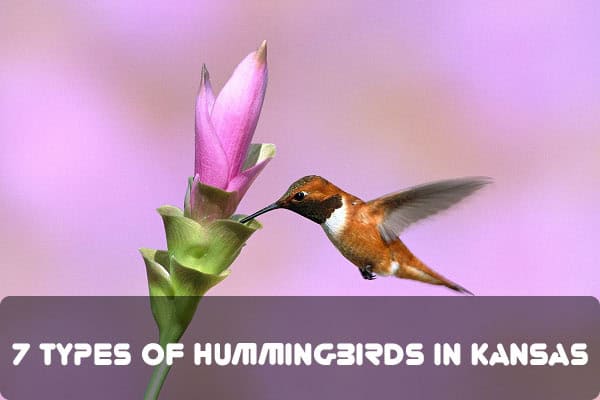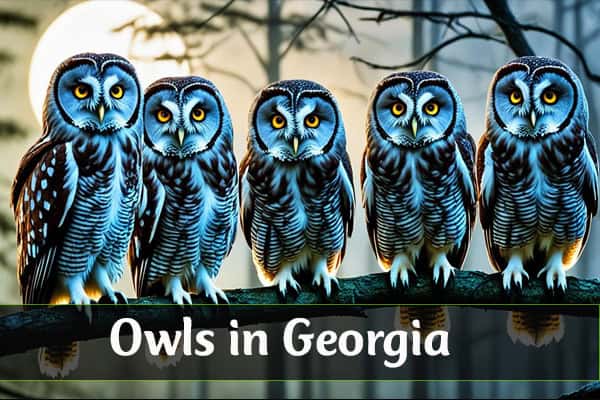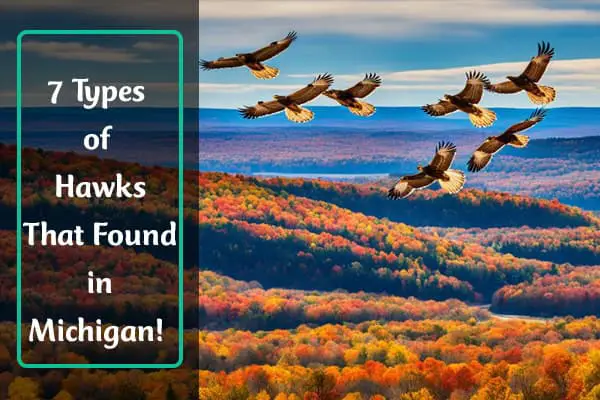7 Types of Hummingbirds In Kansas (With Pictures)
Do you love Hummingbirds in Kansas? Have you ever seen a tiny, shiny bird zip through the air, its wings moving too fast to see? That was probably a hummingbird in Kansas. These small birds are a big deal for bird lovers and nature fans. Kansas has many kinds of hummingbirds, each with its own look and way of acting.
In Kansas, you might see the Ruby-throated Hummingbird or the rare Calliope Hummingbird. But there are more hummingbirds in Kansas than just these two. Get ready to learn about the different hummingbirds that live in this Midwestern state.
Here we’ll discuss about 7 different types of Hummingbirds in Kansas!!!
1. Ruby-throated hummingbird
- Scientific name: Archilochus colubris
- Length: 2.8 to 3.5 in
- Weight: females slightly larger than males (3.4 g to 3.8 g)
- Wingspan: 3.1 to 4.3 in
- Lifespan: 5-7 years
- Conservation Status: Least Concern
The ruby-throated hummingbird is a common sight in Kansas, especially in the eastern part of the state. These birds are small and shine brightly, with males showing off their bright red throats. They’re known for their amazing migration, flying from Kansas to Mexico without stopping.
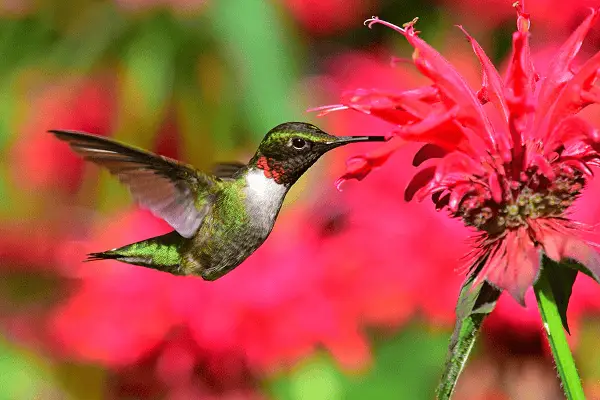
To spot a ruby-throated hummingbird, look for the male’s red throat and black chin. The female has a less vibrant look, with a white throat and greenback. You can attract these birds to your yard by offering nectar feeders and planting flowers that match their needs.
Hummingbirds start to visit Kansas in mid-April. They need to eat a lot to keep up their fast metabolism. A mix of one cup of sugar to four cups of water is best for their feeders. It’s also important to change the sugar water often and clean the feeder.
To draw more ruby-throated hummingbirds, plant flowers they love, like petunias and salvias. The Kansas Department of Wildlife and Parks suggests using salad oil on your feeders to keep ants away.
Learning about the ruby-throated hummingbird’s looks and eating habits can help you make your yard a welcoming place. This way, you can enjoy these beautiful birds all spring and summer in Kansas.
Looking for these rare hummingbirds can be thrilling in Kansas. With patience and a sharp eye, you might see these colorful birds.
| Hummingbird Species | Typical Range | Sightings in Kansas |
|---|---|---|
| Ruby-throated Hummingbird | Eastern U.S. | Common, mostly in eastern Kansas |
| Black-chinned Hummingbird | Western U.S. | Rare, mostly in western Kansas |
| Rufous Hummingbird | Western U.S. | Uncommon, seen in eastern Kansas |
| Calliope Hummingbird | Western U.S. | Rare, mostly in western Kansas |
| Broad-tailed Hummingbird | Western U.S. | Rare, mainly in western Kansas |
| Anna’s Hummingbird | Western U.S. | Rare, primarily in eastern Kansas |
| Broad-billed Hummingbird | Southwestern U.S. | Extremely rare in Kansas |
| Costa’s Hummingbird | Southwestern U.S. | Extremely rare in Kansas |
“Keeping an eye out for these rare hummingbird species can make for an exciting bird watching experience in Kansas. With patience and a keen eye, birders may be rewarded with a glimpse of these vibrant and elusive visitors to the state.”
2. Anna’s Hummingbird
- Scientific name: Calypte Anna
- Length: 3.9 – 4.3 inches
- Weight: 0.1 to 0.2 oz
- Wingspan: 4.7 inches
- Lifespan: 3-5 years
- Conservation Status: Least Concern
The Anna’s hummingbird is common in some parts of North America but rare in Kansas. It stands out with its red crown. Both males and females have a reddish-pink throat patch, but the males’ is bigger and brighter.
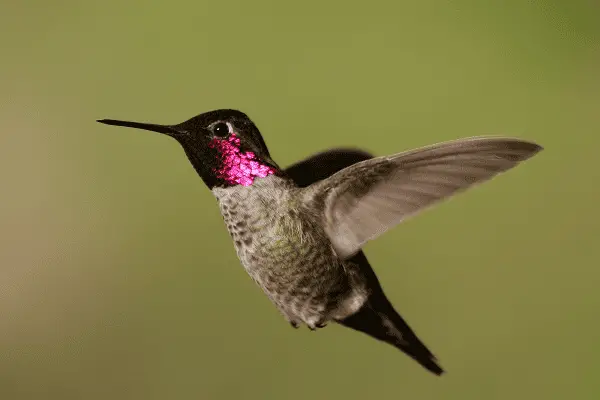
To see an anna’s hummingbird in Kansas, check public gardens or places with exotic flowers. They love to eat from these plants. You can also hear its unique call to know it’s around. This call helps with hummingbird identification and spotting Anna’s hummingbird in Kansas.
“The Anna’s Hummingbird is known for its distinct red crown, a feature that sets it apart from other North American hummingbirds.”
Anna’s hummingbird is a sight to see with its bright colors and noble look. Birders feel lucky to see this rare hummingbird in Kansas. Its rare visits make seeing it even more special.
3. Allen’s Hummingbird
- Scientific name: Selasphorus Sasin
- Length: 3 — 3.5 inches
- Weight: 0.71 – 0.176 ounces
- Wingspan: 3 inches
- Lifespan: 3-5 years
- Conservation Status: Least Concern
The Anna’s hummingbird is rare in Kansas, but the Allen’s hummingbird is even harder to see. This small, colorful bird lives mainly in the western U.S. But, some wanderers might show up in Kansas during their migration.

The Allen’s hummingbird stands out with its rusty look. Males have an orange-red throat and a rust-colored tail. Females are mostly green but share the male’s tail feathers. Young Allen’s hummingbirds look a lot like female rufous hummingbirds, making them hard to tell apart.
To spot an Allen’s hummingbird, look for these signs:
- Rusty, cinnamon-colored flanks, rump, and tail
- Iridescent orange-red throat in males
- Green upperparts and white underparts in females
- Small size, like a ruby-throated hummingbird
- Aggressive, territorial behavior
Seeing the Allen’s hummingbird in Kansas is rare. But bird lovers should watch for this rare and colorful bird during the migration season.
4. Black-Chinned Hummingbird
- Scientific name: Archilochus Alexandri
- Length: 3.5 inches
- Weight: Unknown
- Wingspan: unknown
- Lifespan: 3-5 years
- Conservation Status: Least Concern
The ruby-throated hummingbird is common in Kansas, but the black-chinned hummingbird is a rare sight. This hummingbird is named for its black “chin” and throat. It’s mostly found in the western U.S. but sometimes visits Kansas.

Nesting Strategies of the Black-Chinned Hummingbird
Black-chinned hummingbirds are rare in Kansas, but they like places with lots of flowers. The female builds a nest with plant fibers and spider web silk. She puts it 6 to 12 feet high.
These hummingbirds often nest near big birds that wouldn’t eat them. This is because they’re small and not very tasty.
If you see a black-chinned hummingbird in Kansas, you’re really lucky. They’re not often seen here. Their visit is exciting for those who like hummingbird identification. Keep an eye out for them and record any rare hummingbird sightings in Kansas. Your notes could help us learn more about these amazing birds.
5. Broad-Tailed Hummingbird
- Scientific name: Selasphorus Platycercus
- Length: 4 inches
- Weight: 0.13 oz
- Wingspan: 5.25 inches
- Lifespan: 5-7 years
The broad-tailed hummingbird is a standout in Kansas’s bird world. It’s not always here, but it visits during its migration. This makes it a special sight for bird lovers.

These hummingbirds are easy to tell apart because of their looks. Males have a bright rose-red throat or gorget, that females don’t. They live in places with pine or oak trees and love flowers with lots of nectar.
Their courtship is truly amazing. Males fly high and then dive down in a stunning show. They make a special sound with their feathers. This is to attract females and show off their territory.
These hummingbirds are smart about where they nest. About 70% of the females come back to the same spot every year. This saves them energy and resources during breeding.
If you love birds or nature, seeing a broad-tailed hummingbird in Kansas is unforgettable. Its bright colors, amazing flying skills, and unique courtship make it a wonder of the bird world.
Check Our Previous Articles:
| Mousebirds |
| How To Get Kids Interested In Birdwatching |
| Falcons That Live in Michigan |
| Blackbirds (Icteridae) |
6. Calliope Hummingbird
- Scientific name: Selasphorus Calliope
- Length: 2.8–3.9 in
- Weight: 0.071 to 0.106 oz
- Wingspan: 4.3 in
- Lifespan: 3-5 years
In Kansas, the calliope hummingbird is the smallest bird species. It’s one of the rarest hummingbirds in the Sunflower State. You can mostly see it in the east, between Lawrence and Ottawa.
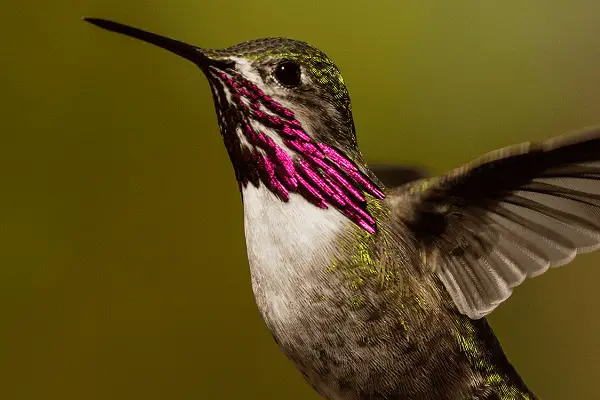
This hummingbird is small but interesting. It eats nectar and sap, which it gets from holes made by other birds. It also likes to nest near pine trees, using the bases of pine cones.
Conservation Efforts for the Calliope Hummingbird
The calliope hummingbird’s numbers are going down. This is because non-native plants are taking over its food sources. To save this bird, groups are working hard to protect its home.
- The Audubon Society says the calliope hummingbird needs special help to survive.
- The Cornell Lab of Ornithology uses the eBird program to track these birds. They ask birdwatchers to report where they see them.
- In Kansas, local groups are planting native plants and teaching people why it’s important for hummingbirds.
We can help the calliope hummingbird by spreading the word and taking action. This way, it can keep flying over Kansas for many years.
7. Rufous Hummingbird
- Scientific name: Selasphorus rufus
- Length: 2.8–3.5 in
- Weight: 0.071–0.176 oz
- Wingspan: 4.3 in
- Lifespan: 3-5 years
If you’re into birdwatching in Kansas, you might see the Rufous Hummingbird. It’s known for being bold and fearless. The male has a bright orange-red throat, while the female has a smaller amount of orange on her throat.
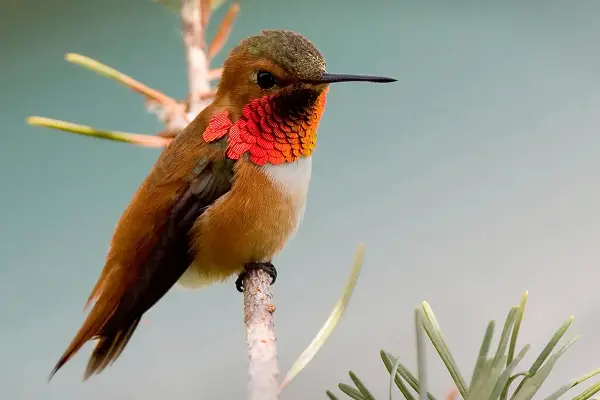
Rufous Hummingbirds are small but brave. They defend their territory fiercely and even attack bigger birds like kestrels and hawks. In Kansas, you might see them as they move through, either going to their summer home or heading south for winter.
In 2018, the Rufous Hummingbird was listed as “Near Threatened.” This means we need to watch over them more closely. By watching and reporting these birds, you help protect this amazing bird.
Frequently Asked Questions:
Q1. Are there hummingbirds in Kansas?
Yes, there are hummingbirds in Kansas, especially during the summer.
Q2. When to put hummingbird feeders out in Kansas?
You should put hummingbird feeders out in Kansas in mid-April.
Q3. Which US state has the most hummingbirds?
Arizona has the most hummingbirds in the US.
Q4. Where are hummingbirds most common?
Hummingbirds are most common in Central and South America.

